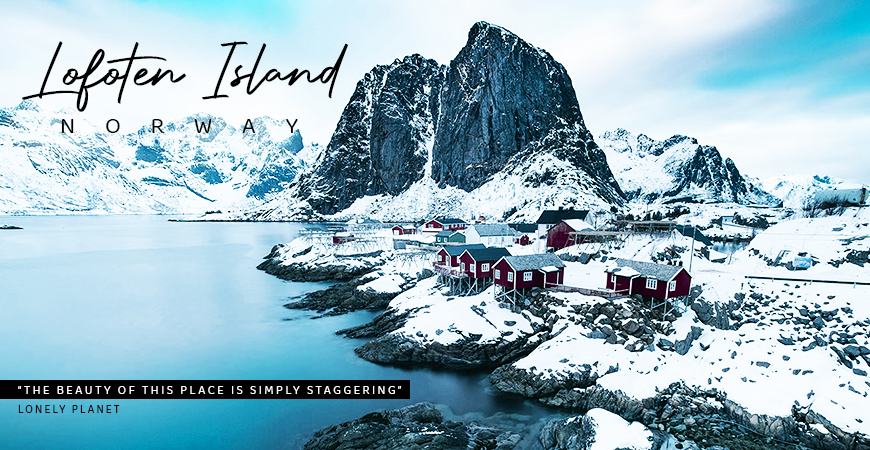Lofoten Island – “The beauty of this place is simply staggering.” Lonely Planet.
Island despite its Arctic locale, the Lofoten archipelago benefits from a unique microclimate created by the Gulf Stream, meaning that you can actually hike, swim, fish, dive, surf, and kayak most months out of the year.
Language: Norwegian & Sami
Population: 25,000
Total Area: 1,227 km2 (474 sq mi)
Sources of Income: Fishing
With dramatic, imposing beauty as far as the eye can see, Norway’s Lofoten Islands are like nowhere else on earth. It’s located far north of the Arctic Circle.
This Island has endless things to surprise you in every moment e.i. crystal clear water of fjords, remarkable sandy beaches, incredible peaks of granites, mid-night Sun (Between late May and mid-July), Northern Lights (end of August to mid-October), etc.
While Tromsø and Alta steal the headlines for aurora spotting in Norway, the lack of artificial light makes the Lofoten islands an intriguing alternative.
It’s hard to believe on the same latitude these islands are surprisingly mild due to the Gulf Stream, the North Atlantic Current, and the Norwegian Current.
If you are seeking unforgettable nature experiences, Lofoten will definitely not let you down. Due to the area’s diverse landscape, you can go hiking, skiing, fishing, ocean rafting, or scuba diving. Lofoten is also one of the world’s northernmost sites for surfing but not suggestable for beginners.
Now how to reach, there are several ways to reach this Sustainable Destination.
By plane/ ferry or express boat
Duration: 1.5-5 hours by plane + express boat.
Oslo to Bodø: 1+ Daily flight, duration 1h 25m.
Trondheim to Bodø: 11 flights per week, duration 55m
Hence, Air travel is the fastest and most efficient way to reach Lofoten. Air travel is the fastest and most efficient way to reach Lofoten. Several airlines offer daily departures to the town of Bodø with a flight time of an hour and a half. Bodø is considered a gateway town to reach the various islands and from here you can choose a connecting flight or catch a ferry or express boat to one of the islands.
Some airlines fly to Leknes, Narvik, Røst, and Svolvær, usually with a stopover of 30 minutes to 3 hours in Bodø. Flight times to these destinations vary from 2 to 5 hours. On a clear day, you’ll want to choose a window seat for fabulous aerial views.
By Train/ ferry or express boat
Duration: 18 hours + ferry or express boat
Traveling by train is comfortable and scenic, albeit a long journey from Oslo. Trains depart a few times a day. The route goes from Oslo to Trondheim-6½ hour ride—where you’ll transfer trains to continue on to Bodø—around 10 hours, with a total journey time of around eighteen hours with transfers included. It is recommended you book a sleeper car on the leg that you travel at night to ensure a good nights’ rest.
Traveling inland, you’ll see mountain passages, lakes, and rivers with many landscapes that are usually not seen or accessible by car. The train passes through the Arctic Circle, however, there isn’t a stop to visit the area. There is a restaurant carriage that serves hot meals, sandwiches, snacks and offers an array of drinks. You are also welcome to bring your own meals. Wi-fi is provided and outlets are available to keep your devices charged.
Once arriving in Bodø, you can catch a ferry or the express boat.
By Car/ ferry or express boat
Duration: 16 hours
Going by car takes around sixteen hours to drive 743 miles (1,195 km). When you set out from Oslo, you’ll take the E6—the highway that goes from Southern to Northern Norway—making the drive straightforward. This route takes you through mountain passages, lakes, rivers, and fjords. After 6 hours on the road, you’ll likely want to stop to stretch your legs and grab a bite to eat and the city of Trondheim is a great place to stop.
Shortly after you pass by the city of Trondheim, you’ll see the Trondheim fjord. Later on your journey, you’ll pass by Ranfjorden fjord, both spectacular and worth a pit stop to enjoy the views.
You can drive directly to the Lofoten islands thanks to the E10—a road that was created specifically to connect the islands to the mainland through a series of tunnels and bridges.
Like most highways in Norway, this route has tolls.
As it is a long journey you may take a transit stay at Trondheim.
Hotels at Trondheim: Radisson Blu Royal Garden Hotel/ Scandic Nidelven/ Clarion Hotel/ similar
Some of the comforts stay as below:
Thon Hotel Lofoten – https://www.thonhotels.no/hoteller/norge/lofoten/
Nordis Hotel & Suites – https://www.nordissuites.com/en/
Anker Brygge – https://anker-brygge.no/
Lofoten Island is famous for Seafood such as Stockfish Royal, Cured whale, Stockfish brandade, Salted codfish. While visiting Svolvaer the capital of Lofoten Island must-visit restaurant, The BørsenSpiseri – built-in 1828.
Hence, whenever you are traveling to Norway please keep at least 4/5 Days to spend at Lofoten Island, a lifetime experience.


Comment (0)